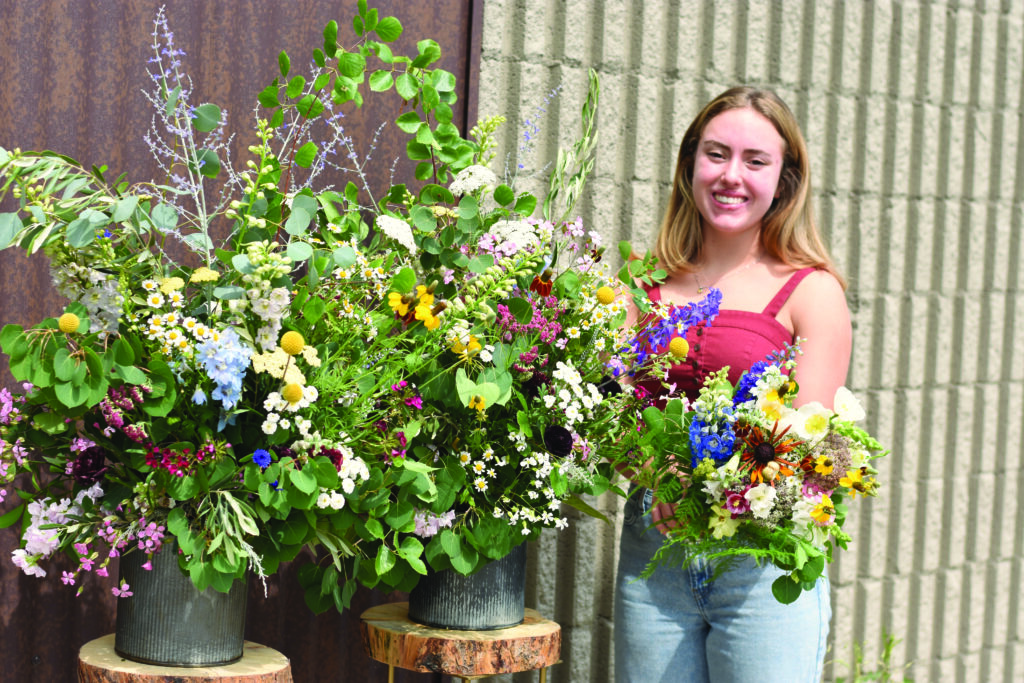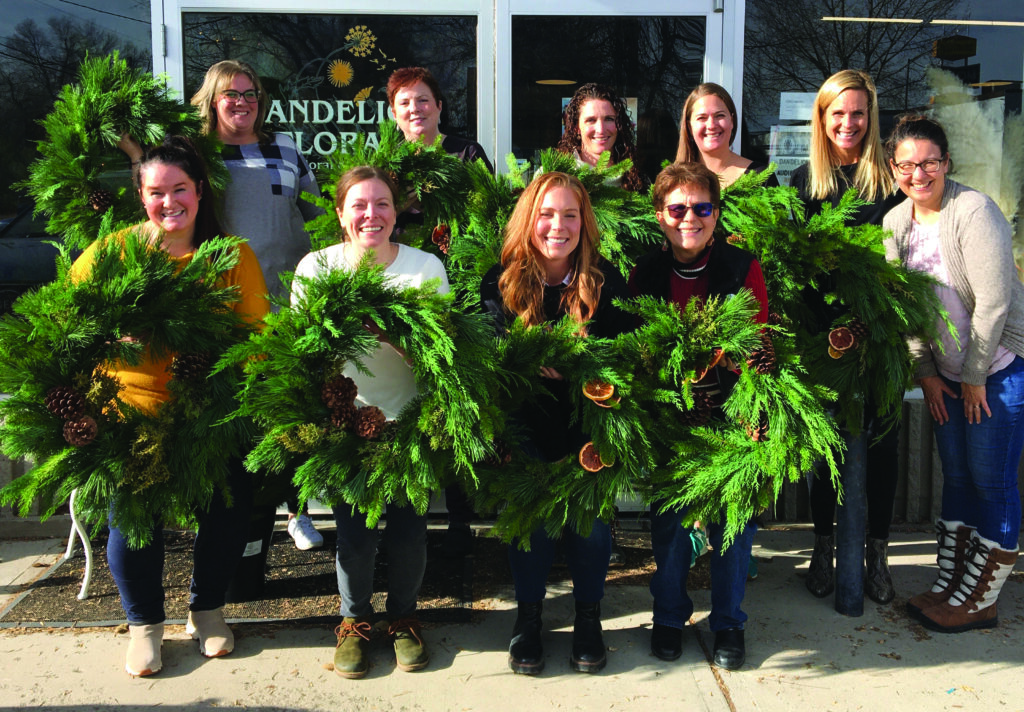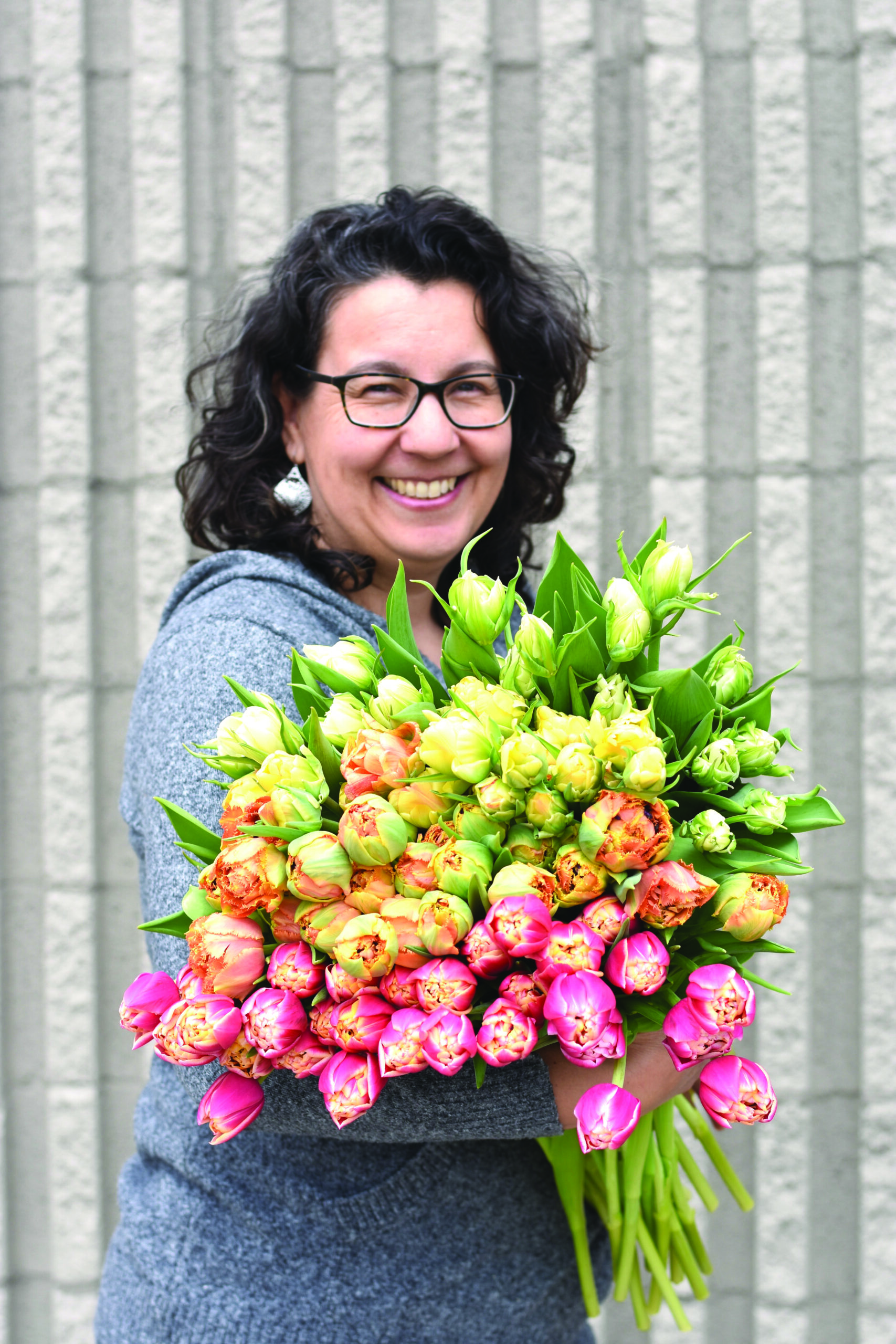

Photo Courtesy: Spring Forth Farm






Meet a Grower
A Micro Farm Blooms with Wildflower Abandon
Teresa Tibbets, Dandelion Floral
Wyoming wedding florals bring a rural flower farm to life and lead a farmer back to her first love.
Growing flowers in Zone 4B means the season is short, but farming in the Rocky Mountain West ratchets up the intensity by coupling extremely snowy, wet winters with hot, desert-dry summers. “It’s like living in two different climates,” says Teresa Tibbets, founder of Dandelion Floral in Lander, Wyoming.
As a farmer florist, Teresa juggles the region’s seasonal extremes to raise a crop mix that provides the foundation for her wedding designs. “My business model is roughly 80 percent full-service weddings, 10 percent pick-up wedding orders and 10 percent workshops,” she says. A 700-square-foot studio space in downtown Lander provides the venue for design and community workshops.
Teresa started her business in 2015 with a mix of herbs and lettuce for the local farmers’ market. As the market season wound down, her offerings dwindled, too, so she cut the native branching sunflowers in her garden and added them to her stand. The flowers sold out three weeks in a row, and she discovered flower farming shortly after.

“I always say the flowers found me,” she says. “Every year, I grew more flowers and offered more services. The process happened slowly and organically.” By 2020 Teresa was growing flowers and designing full-time. Her passion for gardening made the transition to full-time growing easier, as did her knowledge of soils and ecology. “I worked 20 years as a biologist with a specialty in river and floodplain systems,” she shares. “Those studies and understanding the local environment have really helped me in my farming career.”
Building a Wedding Business
With a focus on designing for weddings, Teresa savors the progression of “designing from seed to centerpiece. That’s really rewarding,” she says. “I start seeds in February and March, and then see everything come together at events. I definitely love the process.”
Lander is 160 miles from Jackson Hole, a destination wedding center. Teresa got her foot in the door with the local wedding planners by sending a “few emails with some pictures and a little description of what I do. A few planners responded, ones whose values aligned with my ecofriendly wedding aesthetic, and now they’re my biggest champions,” she explains. “That was a really big learning curve for me. I didn’t have a lot of traction in the Jackson Hole wedding market until I connected with the planners.”
Making the jump to doing larger weddings and installations opened up opportunities for Teresa. “It meant that I could hire a team,” she says, which includes 4 part-time helpers in summer. This year Teresa is doing 12 full-service weddings, most of which are in Jackson Hole.
“Many of these weddings take place at private ranches, so we have specialized in going to remote locations—usually a 2- to 3-hour drive. Because our flowers are so fresh, mostly coming from the farm, that gives them a lot of resilience against all the travel time.”
Last year Teresa invested in an insulated, 12-foot trailer; this year she’s hoping to add a cooler to it. “We try to have 80 percent of everything done when we leave the studio, but for the ceremony installations that are so popular now, we just take buckets of flowers,” she says. “It’s really like Tetris, and it’s also stressful because we can’t forget anything.”
She’s developed a triple-check system that means three different people on the team go through everything that’s loaded, literally touching every item to make sure it’s present. “It’s not enough to glance at the dahlia buckets—I want to touch each one. It might sound like overkill, but it works,” she says.
Wedding Design, Wyoming-Style
Wedding season runs from June to October, which coincides with the region’s frost schedule: The last frost is usually the last week of May, and the first frost typically hits in the first week of October.
Teresa primarily uses crops she raises in her design work, although she does supplement with other American-grown flowers, mostly for the bigger weddings. “It’s nice to support other farms,” she says. “Sometimes I can coordinate with other growers in the Jackson Hole area and pick up blooms on the way to weddings. That’s really helpful.”
She also responsibly forages, with permission, a lot of aspen and some wildflowers. “People really appreciate those little touches that are rooted in Wyoming,” she says. “My overall design style is loose and natural, growing out of a garden aesthetic. I’m inspired by nature’s form and structure and embrace the whimsical and wild.” She likes to take cues from the Rocky Mountain environs, which combines the blue-grays of sage and juniper with delicate golden grasses and shimmering yellow-green aspens.
Her focus on floral designs that celebrate the unique ness of Wyoming reflect her own journey as a designer. “I was intimidated by entering the farming community and the floral design aspect, but I’ve found the community very welcoming,” she says. “I started out thinking that I had to design a certain way, but since then I’ve realized there are so many different ways you can approach floral design. You’re either going to find your ideal customer or you’re going to be trying to be something you’re not.”
Challenges Keep It Real
The majority of crops that help create Teresa’s signature Wyoming wedding aesthetic come from her micro farm: 1,200 square feet (including a 16 x 30 hoophouse) in her backyard. “I grow all of our spring flowers at my home,” she says. This includes stock, ranunculus, anemones and snapdragons—all in the hoophouse and beds. She grows these at home because Wyoming spring weather is so variable. “We can go from a snowstorm to 80 degrees in one day,” she explains.
Her focus on cool annuals comes from her knowledge of the local ecology. “We get a lot of our moisture in spring (which means June here, by the way), and I want to take advantage of that with early crops,” she says. Her home garden also offers perennials she can cut for designs, although climate limits these, too. “I’m so envious of growers who can start things in fall and get a crop in spring. I can’t get sweet peas or ranunculus to overwinter successfully.”
The main annual crops she raises come from another location. “In the past, I’ve had crops spread out at different local farms, which was a challenge. I was spending a lot of time driving,” Teresa shares. This year her annuals—sunflowers, zinnias, etc.—will be thriving on 1/8 of an acre at Central Wyoming College (CWC) in nearby Riverton. “They have an incubator farm there, and I was able to get a plot. It will be much more convenient to have everything in one place,” she says.
The Wyoming climate definitely impacts how crops grow, and Teresa has had to adapt to get enough stems for her wedding work. “We don’t get a lot of succession of things. For instance, with lisianthus, we barely get one flush. I can push sunflowers to get two or three successions,” she says. “Dahlias are very marginal for us because we have such a short season.”
When summer arrives, the crop list shifts to western natives, things that thrive with heat and drought, including plants in the Asteraceae, such as echinacea, zinnia, and cosmos. Fall frost hits hard, usually slamming in with 25 degrees—“just about the time the chrysanthemums are really starting to grow,” Teresa says.
“We have so many variables with Mother Nature that it’s important to be able to control water and your space year after year. I want to grow with regenerative processes or to include habitat for pollinators,” she says. While Teresa can do that at home, without having her own farm, those aspirations are limited.
“My greatest challenge here is the price of real estate. I would love to have my own farm and my own space,” she says. During the pandemic, many people relocated to Wyoming, which has driven the price of land beyond Teresa’s reach. “A couple years ago I could hope to find my own farm space, but these days I’m outbid.”
A New Direction Beckons
Since Teresa is having a hard time getting land, she’s shifting her focus from weddings to teaching. Holding workshops at her studio space reminded her how much she loves educating others. “I enjoy that role, helping people get through a project,” she says. She did her first beginner’s cut flower garden class this spring, and it sold out quickly, so she plans to expand that offering.


“Our most popular workshops are the holiday wreath ones,” she says. “I really dislike making wreaths, but I can show others how to do it. At that time of year, people are really excited to share experiences with family and friends—and they spend more during the holidays. It’s nice to connect with that trend,” she says. For some attendees, the workshop has become a holiday tradition.
Wine, snacks and holiday music keep spirits jolly during the event. “I hold the wreath workshops between Thanksgiving and December 5, so it’s early in the holiday season. That lets me take advantage of all the spending people do at that point and frees us up well before Christmas,” she says.
But workshops are just one part of Teresa’s educational game plan. Last fall she taught horticultural science at CWC and realized she’d been missing that aspect of her life. “I really want to start helping farmer florists—those who don’t have the science background to help them get through questions or research processes,” she says. “I’d like to start providing educational content for folks who want to know more about the why behind what they do so they can gain a better understanding of farming processes.
“I take for granted a lot of the ecological processes that I know are happening and that I spend time fostering on my farm. When people understand the whys of decisions they need to make, that’s really important,” she shares. Teresa plans to step away from weddings next year to focus on developing educational content. She envisions having small workshops related to farming, ecology and regenerative processes.
“I don’t know what the future will bring in terms of flowers, but I’ll always be growing,” she says. “If you’re motivated to create beauty, you can go a long way in this industry. Curiosity and a sense of wonder will take you far. In farming, it’s easy to get lost in the numbers and the pressure to produce. We have to remember why we’re doing it and keep that passion alive.”
Julie Martens Forney is an avid gardener and freelance writer who’s been writing about flower and plant production, horticulture research, and consumer gardening for over 30 years. Contact her at [email protected]
______
Originally published in The Cut Flower Quarterly, Summer 2023





